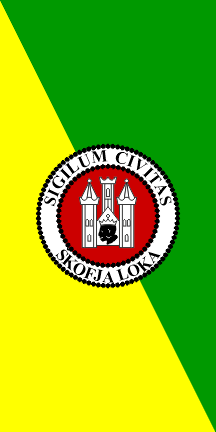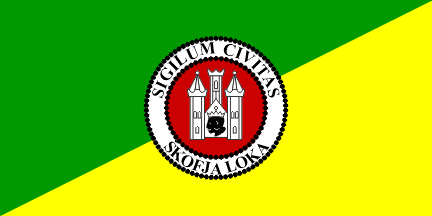
The name Škofja Loka derives from the medieval times and it was originally named Loka, which means wet, grassy area near water. However, at that time there were many Lokas in Slovenia, and there had already existed a rural settlement named Loka (today’s Stara Loka) not very far from the town, therefore later on Škofja was added to the name Loka.
This adjective is linked with the donation of the Loka region to the Bishops of Freising, and the town of Loka was thus renamed to Škofja Loka. There is a Negro with a crown in all symbols of Loka, which relates to the legend about the land lord Abraham and his servant. The legend says that they were travelling along the Poljanska dolina valley and they met a big bear in dark woods. Bishop Abraham stopped, but the Negro drew a bow and shot the bear. Abraham had the head of the Negro pictured in the town coat-of-arms in order to thank the servant for having saved his life.
See http://www.skofja-loka.com/home/about-our-towns/skofja-loka.aspx

Haplogroup E3b1a2 as a Possible Indicator of Settlement in Roman Britain by Soldiers of Balkan Origin
Steven C. Bird
Abstract
The invasion of Britain by the Roman military in CE 43, and the subsequent occupation of Britain for nearly four centuries, brought thousands of soldiers from the Balkan peninsula to Britain as part of auxiliary units and as regular legionnaires. The presence of Haplogroup E3b1a-M78 among the male populations of present-day Wales, England and Scotland, and its nearly complete absence among the modern male population of Ireland, provide a potential genetic indicator of settlement during the 1st through 4th Centuries CE by Roman soldiers from the Balkan peninsula and their male Romano-British descendants. Haplotype data from several major genetic surveys of Britain and Ireland are examined, analyzed and correlated with historical, epigraphic and archaeological information, with the goal of identifying any significant phylogeographic associations between E3b1a-M78 and those known Romano-British settlements and military posts that were associated specifically with Roman soldiers of Balkan origin. Studies by Cruciani et al. (2007), Pere?i? et al. (2005), and Marjanovic et al. (2005), examining the distribution of E3b1a-M78 and E3b1a2-V13 in the Balkans, are analyzed further to provide evidence of phylogeographic associations between the E3b1a2 haplotypes identified within the Balkans by these studies and those regions of the Balkans occupied first by the Roman army in antiquity. E3b1a2 is found to be at its highest frequency worldwide in the geographic region corresponding closely to the ancient Roman province of Moesia Superior, a region that today encompasses Kosovo, southern Serbia, northern Macedonia and extreme northwestern Bulgaria. The Balkan studies also provide evidence to support the use of E3b1a-M78 (in the present study) as a close proxy for the presence of E3b1a2-V13 (representing 85% of the parent E3b1a-M78 clade) in both the Balkans and in Britain.


Y Haplogroup E-M215 or E3b
In human genetics, Y Haplogroup E-M215, also referred to in the literature by other names such as E1b1b and E3b (see further discussion below), is a major Y-chromosome haplogroup. It is a division of the macro haplogroup E-M96, which is defined by the single nucleotide polymorphism (SNP) mutation M215.[4][5][6] In other words it is one of the major paternal lines of humanity, linking from father-to-son back to a common male-line ancestor. It is a subject of discussion and study in genetics as well as genetic genealogy, archaeology, and historical linguistics.
E-M215 has two ancient branches that contain all known modern E-M215 men, E-M35 and E-M281. Of these two, the only branch that has been confirmed in a native population outside of Ethiopia is E-M35, which in turn has four known branches, E-V68, E-Z827, E-V6 and E-V92. The first two, E-V68 and E-Z827 contain by far the majority of all modern E-M215 men. E-V68 and E-V257 have been found in highest numbers in North Africa and the Horn of Africa; but also in lower numbers in parts of the Middle East and Europe, and in isolated populations of Southern Africa. The remaining two branches, E-V6 and E-V92 have mostly been observed in Ethiopia.
E-V68
In human genetics, E-V68, is a major Y chromosome haplogroup found in Africa, Western Asia and Europe, and is in turn part of the larger haplogroup known as E-M35. It is identified by the presence of a single nucleotide polymorphism (SNP) mutation on the Y chromosome known as V68. It is a subject of discussion and study in genetics as well as genetic genealogy, archaeology, and historical linguistics.
E-V68 is dominated by its longer-known subclade E-M78. In various publications, both E-V68 and E-M78 have been referred to by other names, especially phylogenetic names such as “E3b1a” which are designed to show their place on the family tree of all humans. These various names change as new discoveries are made and are discussed below.
See http://en.wikipedia.org/wiki/Haplogroup_E-V68


Hmmm…. a servant that wears a crown and is associated with a castle? Interesting.
Lol! Intersting indeed….I wonder what the true story is.